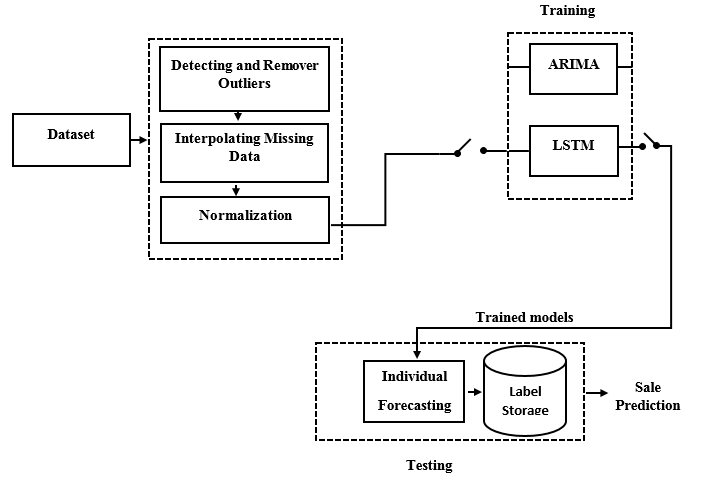Sales Prediction of Cardiac Products by Time Series and Deep Learning
Keywords:
Cardiac Products, Balloons, Stents, Time Series, Deep Learning, Decision SupportAbstract
Maintaining inventory level to avoid high inventory costs is an issue for Cardiac Product Distribution Companies (CPDCs) because of the shortage of their products which affect their sale and causes loss of the customer. This research aims to provide a method for predicting the upcoming demand of the Balloon and Stents by using time series analysis (Auto Regression Integrated Moving Average) and Deep learning (Long-Short Term Memory). To conduct this research, data was collected from Pakistan’s leading cardiac product distributors to determine the method's performance. The findings were compared using Mean absolute error (MAE) and Root Mean Square Error (RMSE). Resulst conclude that the ARIMA algorithm successfully forecasts cardiac products sale.
References
A. Gupta, C. D. Maranas, and C. M. McDonald, “Mid-term supply chain planning under demand uncertainty: customer demand satisfaction and inventory management,” Comput. Chem. Eng., vol. 24, no. 12, pp. 2613–2621, Dec. 2000, doi: 10.1016/S0098-1354(00)00617-7.
R. Kaipia, J. Holmström, J. Småros, and R. Rajala, “Information sharing for sales and operations planning: Contextualized solutions and mechanisms,” J. Oper. Manag., vol. 52, pp. 15–29, May 2017, doi: 10.1016/J.JOM.2017.04.001.
“Sales Forecasting Methodology: A Beginner’s Guide | Anaplan.” https://www.anaplan.com/blog/sales-forecasting-guide/ (accessed Jun. 24, 2022).
Y. Niu, “Walmart Sales Forecasting using XGBoost algorithm and Feature engineering,” Proc. - 2020 Int. Conf. Big Data Artif. Intell. Softw. Eng. ICBASE 2020, pp. 458–461, Oct. 2020, doi: 10.1109/ICBASE51474.2020.00103.
R. A. Hussain. I, Javed. R.R, Qayyum. H., Farman. H, “Detection of Coronary Artery Using Novel Optimized Grid Search-based MLP,” Int. J. Innov. Sci. Technol., vol. 4, no. 1, pp. 276–287, 2022.
P. Doganis, A. Alexandridis, P. Patrinos, and H. Sarimveis, “Time series sales forecasting for short shelf-life food products based on artificial neural networks and evolutionary computing,” J. Food Eng., vol. 75, no. 2, pp. 196–204, Jul. 2006, doi: 10.1016/J.JFOODENG.2005.03.056.
D. C. S. Bisht and M. Ram, Recent advances in time series forecasting. .
S. Pilemalm, P. O. Lindell, N. Hallberg, and H. Eriksson, “Integrating the Rational Unified Process and participatory design for development of socio-technical systems: a user participative approach,” Des. Stud., vol. 28, no. 3, pp. 263–288, 2007, doi: 10.1016/j.destud.2007.02.009.
“time series - Confused on ARIMA’s linearity assumption - Cross Validated.” https://stats.stackexchange.com/questions/468477/confused-on-arimas-linearity-assumption (accessed Jun. 24, 2022).
I. Khandelwal, R. Adhikari, and G. Verma, “Time Series Forecasting Using Hybrid ARIMA and ANN Models Based on DWT Decomposition,” Procedia Comput. Sci., vol. 48, no. C, pp. 173–179, Jan. 2015, doi: 10.1016/J.PROCS.2015.04.167.
I. A. Gheyas and L. S. Smith, “A novel neural network ensemble architecture for time series forecasting,” Neurocomputing, vol. 74, no. 18, pp. 3855–3864, Nov. 2011, doi: 10.1016/J.NEUCOM.2011.08.005.
“Deep Learning | Guide books.” https://dl.acm.org/doi/abs/10.5555/3217337 (accessed Jun. 24, 2022).
A. Soy Temür and Ş. Yıldız, Comparison of Forecasting Performance of ARIMA LSTM and HYBRID Models for The Sales Volume Budget of a Manufacturing Enterprise, vol. 50, no. 1. 2021.
P. Newbold, “ARIMA model building and the time series analysis approach to forecasting,” J. Forecast., vol. 2, no. 1, pp. 23–35, Jan. 1983, doi: 10.1002/FOR.3980020104.
“Understanding LSTM Networks -- colah’s blog.” https://colah.github.io/posts/2015-08-Understanding-LSTMs/ (accessed Jun. 24, 2022).
A. Deng et al., “Developing Computational Model to Predict Protein-Protein Interaction Sites Based on the XGBoost Algorithm,” Int. J. Mol. Sci., vol. 21, no. 7, Apr. 2020, doi: 10.3390/IJMS21072274.
A. Soy Temür, M. Akgün, and G. Temür, “Predicting housing sales in turkey using arima, lstm and hybrid models,” J. Bus. Econ. Manag., vol. 20, no. 5, pp. 920–938, 2019, doi: 10.3846/jbem.2019.10190.
S. Siami-Namini, N. Tavakoli, and A. Siami Namin, “A Comparison of ARIMA and LSTM in Forecasting Time Series,” Proc. - 17th IEEE Int. Conf. Mach. Learn. Appl. ICMLA 2018, pp. 1394–1401, Jan. 2019, doi: 10.1109/ICMLA.2018.00227.
N. Khalil Zadeh, M. M. Sepehri, and H. Farvaresh, “Intelligent sales prediction for pharmaceutical distribution companies: A data mining based approach,” Math. Probl. Eng., vol. 2014, 2014, doi: 10.1155/2014/420310.
A. Elmasdotter and C. Nyströmer, “A comparative study between LSTM and ARIMA for sales forecasting in retail,” Degree Proj. Technol., 2018.
C. C. Wang, C. H. Chien, and A. J. C. Trappey, “On the Application of ARIMA and LSTM to Predict Order Demand Based on Short Lead Time and On-Time Delivery Requirements,” Process. 2021, Vol. 9, Page 1157, vol. 9, no. 7, p. 1157, Jul. 2021, doi: 10.3390/PR9071157.
S. Gopal, K. Patro, and K. Kumar Sahu, “Normalization: A Preprocessing Stage,” IARJSET, pp. 20–22, Mar. 2015, doi: 10.48550/arxiv.1503.06462.
S. Karasu, A. Altan, Z. Sarac, and R. Hacioglu, “Prediction of Bitcoin prices with machine learning methods using time series data,” 26th IEEE Signal Process. Commun. Appl. Conf. SIU 2018, pp. 1–4, Jul. 2018, doi: 10.1109/SIU.2018.8404760.
W. Thongpeth, A. Lim, A. Wongpairin, T. Thongpeth, and S. Chaimontree, “Comparison of linear, penalized linear and machine learning models predicting hospital visit costs from chronic disease in Thailand,” Informatics Med. Unlocked, vol. 26, p. 100769, Jan. 2021, doi: 10.1016/J.IMU.2021.100769.
“sklearn.metrics.mean_squared_error — scikit-learn 1.1.1 documentation.” https://scikit-learn.org/stable/modules/generated/sklearn.metrics.mean_squared_error.html (accessed Jun. 24, 2022).

Published
How to Cite
Issue
Section
License
Copyright (c) 2022 50sea

This work is licensed under a Creative Commons Attribution 4.0 International License.




















